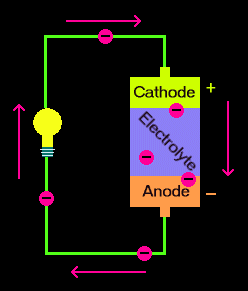پارسی، ترجمه و ویرایش
نکاتی دربارۀ نگارش فارسی، تایپِ درست و ترجمه (اکبر خرّمی)پارسی، ترجمه و ویرایش
نکاتی دربارۀ نگارش فارسی، تایپِ درست و ترجمه (اکبر خرّمی)ترجمۀ متون ساده – متن ۲
ترجمۀ متون ساده – متن ۲
شنبه ۲۴ مهر ۹۵
فونت «یاس» را از اینجا دانلود و روی رایانۀ خود نصب کنید تا همه نوشتههای فارسیِ این وبلاگ را زیباتر ببینید.
How
do batteries work?
Electricity, as you probably already know, is the flow of electrons through a conductive path like a wire. This path is called a circuit.
Batteries have three parts, an anode (-), a cathode (+), and the electrolyte. The cathode and anode (the positive and negative sides at either end of a traditional battery) are hooked up to an electrical circuit.
The chemical reactions in the battery causes a build up of electrons at the anode. This results in an electrical difference between the anode and the cathode. You can think of this difference as an unstable build-up of the electrons. The electrons want to rearrange themselves to get rid of this difference. But they do this in a certain way. Electrons repel each other and try to go to a place with fewer electrons.
In a battery, the only place to go is to the cathode. But, the electrolyte keeps the electrons from going straight from the anode to the cathode within the battery. When the circuit is closed the electrons will be able to get to the cathode. In the picture above, the electrons go through the wire, lighting the light bulb along the way. This is one way of describing how electrical potential causes electrons to flow through the circuit.


























